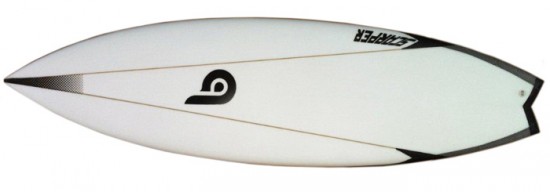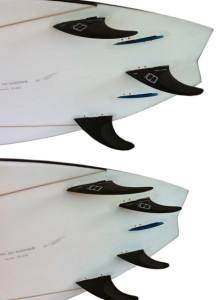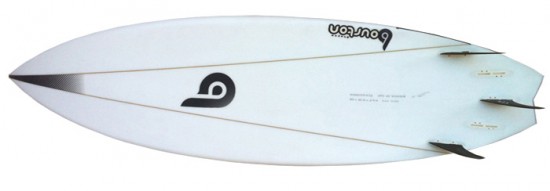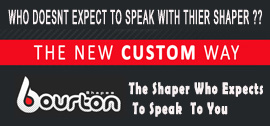Technical Stats – THE SCARPER
New fused pellet polystyrene core.
New duel density polystyrene construction.
New double diagonal flex stringers.
BDX 4×4 lightweight glass system.
Carbon reinforced flex tail.
New 5 fin- long and short combination boxes.
At long last I now feel that I can offer an EPS product into the market without any fear of failure. Previously I have felt that for the extra cost (epoxy construction) to the customer and with the extra risk of water sucking into the foam if damaged in action- customer satisfaction could be very short lived. A company called Core Fusion have developed a polystyrene that does not absorb water, but still retains all the same qualities such as buoyancy and lightness.

In order to give this model a little more tail twang I have adopted 2 diagonal stringers which the flex guru Mitchell Rae calls the V2. He has been developing the idea where the 2 stringers hit the rail just ahead of the front fins allowing the last part of the tail to flex more without any timber support. In addition 2 stringers (for breakage) have to be stronger than just one. Also the fact that they do not run nose to tail means they will have a little more flex particularly if they are glassed with the BDX system. One layer of 4oz diagonally top and bottom does everything to encourage the spring of the two stringers and also the flex in the tail in particular.
I have also used a denser foam in the middle where all the footwork goes on and a lighter foam out on the rails where there is less traffic. This duel density is smart protection when there is only one layer of 4 oz on the deck. The point where the stringer meets the rail at the tail, I have reinforced with a strong black carbon patch both sides so that any extreme flexing does not stress this very vulnerable point. In addition I have run the lighter striped carbon off this reinforced station along the rail to the swallow to give the kick back even more ping. The swallow itself is also reinforced with the stronger black carbon as most of my models are these days. Effectively both ends are very durable with the carbon on the swallow and the double stringers meeting at the nose.
I thought the best model to introduce this new combination of EPS and diag stringers was the new Pseudo Fish model. I have widened it more and pinched the rail a tad to accommodate the extra buoyancy that EPS has. I know that this idea will work in any model but the contemporary fish is making a comeback of late so I wanted the board design for this new system to be on the money.
 The Scarper model is 6.0 x 20 ½ x 2 9/16 and has a 4 ½” lowish nose entry which is always going to help this model paddle and run. The width and thickness as well will encourage even bigger guys to come down in size especially with the corkiness of the Core fusion polystyrene.
The Scarper model is 6.0 x 20 ½ x 2 9/16 and has a 4 ½” lowish nose entry which is always going to help this model paddle and run. The width and thickness as well will encourage even bigger guys to come down in size especially with the corkiness of the Core fusion polystyrene.
The fin system is also new. With the inclusion of the new Power Base boxes ( PBB) developed by Greg Trotter, I feel I have value added to this futuristic design by increasing its versatility with extra fin position choices (it’s not rocket science) Using the the longer boxes at the back give this board the opportunity for multiple personalities. In thruster mode when in smaller waves you can increase pivot by simply moving the centre fin forward or as well whilst in that mode, you can steady up the slip by applying the Bourton keels either side.
While in Quad mode you can cluster up the fins for shorter arcs or spread them for more drive on bigger days. If the surf gets even bigger and you need more drive slip in the Bourton keel into the centre box and move it right back and voila!
This model will be the most tech advanced model in my 2012 range and will also be the most expensive. I am very excited about the way this board ticks all the modern day boxes and cannot wait until the day arrives for its official release.
Muzz


